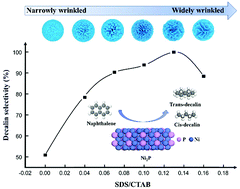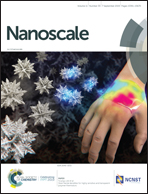Ni2P promotes the hydrogenation activity of naphthalene on wrinkled silica nanoparticles with tunable hierarchical pore sizes in a large range†
Abstract
Herein, a series of wrinkled silica nanoparticles with hierarchical pore (HPWSNs) supports were successfully prepared by dual-templating, and the special wrinkle pore structures in the monodisperse HPWSN samples were found to be beneficial for reducing the diffusion resistance of macromolecular aromatic compounds and achieving high dispersion of Ni2P active phases. Moreover, the distance between wrinkles in silica nanoparticles could be easily tuned by changing the ratios of SDS/CTAB through charge-reversed interactions. It was found that the Ni2P/HPWSNs-0.13 catalyst with smallest Ni2P particles had highest surface area and biggest pore volume. Furthermore, the Ni2P/HPWSNs-0.13 catalyst exhibited highest naphthalene hydrogenation conversion as well as 99.9% selectivity to decalin at 320 °C. To correlate the internal relationship between the macroscopic catalytic performance in the experiment and the atomic chemistry in the microscopic point of view, DFT calculations were performed, and the results showed that stronger adsorptions of naphthalene and tetralin occurred over the Ni(2) sites than those over the Ni(1) sites. Therefore, it can be concluded that the superior catalytic activity of the Ni2P/HPWSNs-0.13 catalyst is due to the synergistic effect of the center-radical framework structure and the small sizes of Ni2P particles, which are conducive to exposing more Ni(2) sites on the support surface, thus inducing more H for the naphthalene hydrogenation reaction.



 Please wait while we load your content...
Please wait while we load your content...